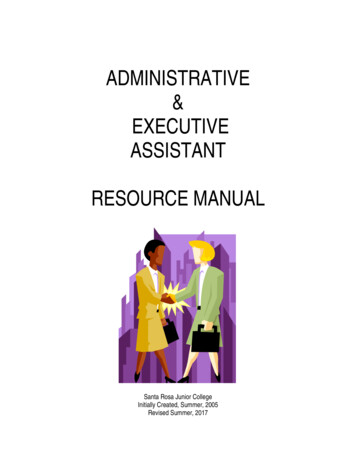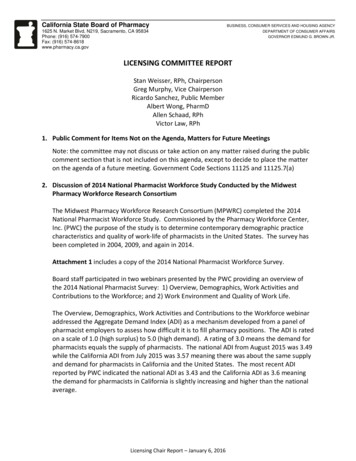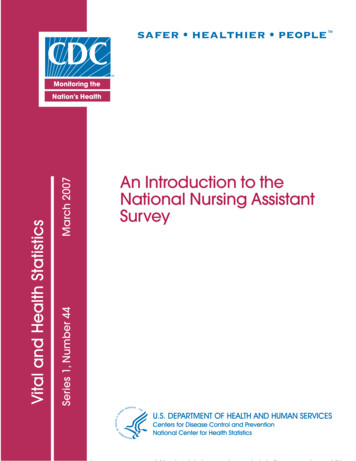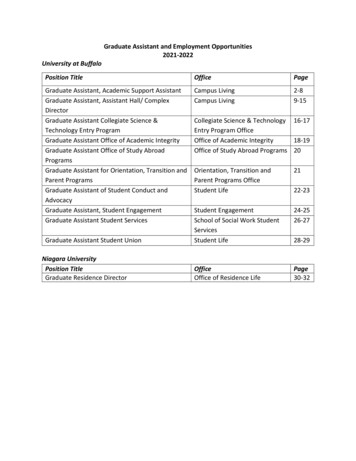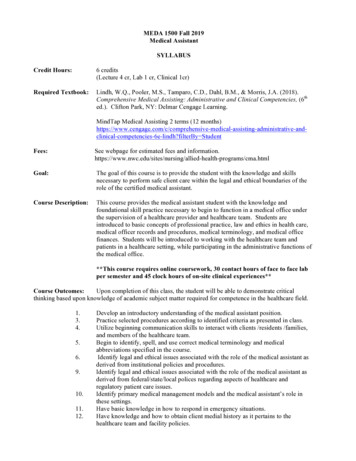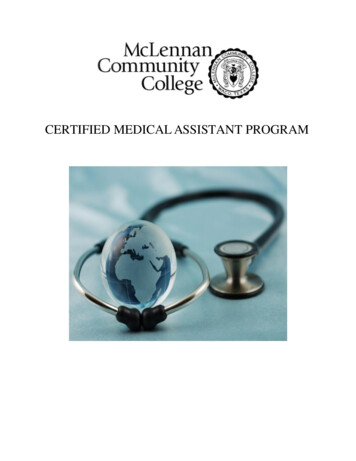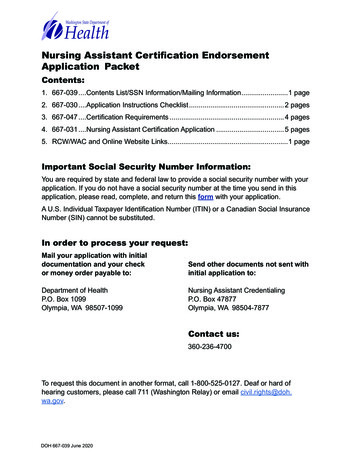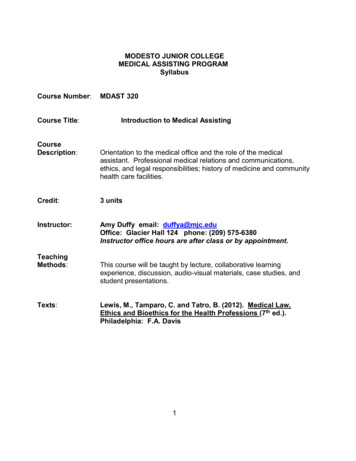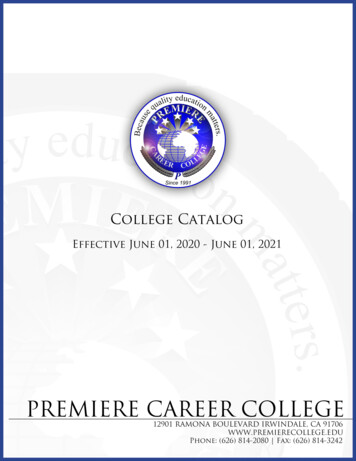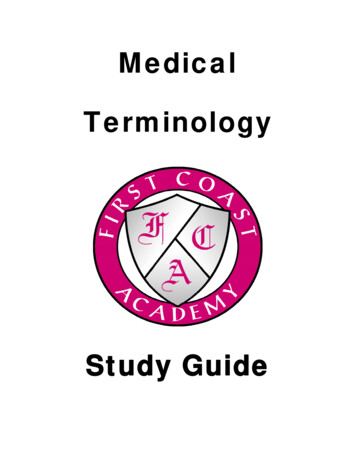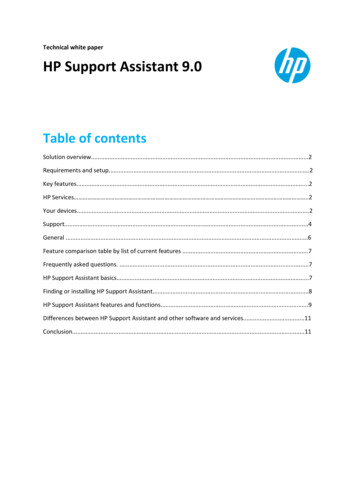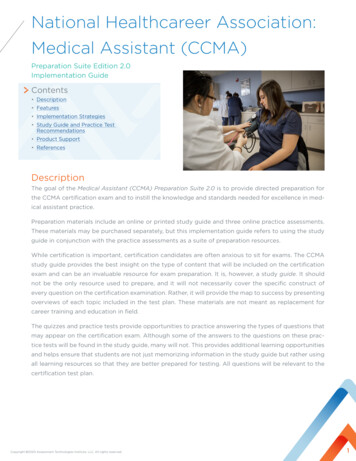
Transcription
National Healthcareer Association:Medical Assistant (CCMA)Preparation Suite Edition 2.0Implementation GuideContents Description Features Implementation Strategies Study Guide and Practice TestRecommendations Product Support ReferencesDescriptionThe goal of the Medical Assistant (CCMA) Preparation Suite 2.0 is to provide directed preparation forthe CCMA certification exam and to instill the knowledge and standards needed for excellence in medical assistant practice.Preparation materials include an online or printed study guide and three online practice assessments.These materials may be purchased separately, but this implementation guide refers to using the studyguide in conjunction with the practice assessments as a suite of preparation resources.While certification is important, certification candidates are often anxious to sit for exams. The CCMAstudy guide provides the best insight on the type of content that will be included on the certificationexam and can be an invaluable resource for exam preparation. It is, however, a study guide. It shouldnot be the only resource used to prepare, and it will not necessarily cover the specific construct ofevery question on the certification examination. Rather, it will provide the map to success by presentingoverviews of each topic included in the test plan. These materials are not meant as replacement forcareer training and education in field.The quizzes and practice tests provide opportunities to practice answering the types of questions thatmay appear on the certification exam. Although some of the answers to the questions on these practice tests will be found in the study guide, many will not. This provides additional learning opportunitiesand helps ensure that students are not just memorizing information in the study guide but rather usingall learning resources so that they are better prepared for testing. All questions will be relevant to thecertification test plan.Copyright 2020 Assessment Technologies Institute, LLC. All rights reserved.1
FeaturesThe study guide, available in both printed and online formats, focuses on the principles of medicalassistant practice as aligned with the CCMA exam blueprint.B OTH THE ON LI N E V ER SI ON A N D P R I N T ED STU DY G U I DE S I N C LU D E TH E F O L LOW I N G F E ATU R E S: Illustrations, images, and tables help to explain and clarify concepts. Glossary terms allow certification candidates to review definitions of selected terms. Quizzes assess candidates’ knowledge of chapter/module content and other relevant subjectmatter related to the test plan. Case studies test the candidate’s ability to think and respond to real-world scenarios.F EATURES ON LY AVA I L A BL E I N T HE ON L I N E V E R S I O N I N C LU DE : Electronic gaming and flashcards to help reinforce learning throughout module sections. Video challenges provide real world critical-thinking practice Professionalism tips provide insights on important soft skills. Video enhancements reinforce information presented in the module. Audio pronunciation of glossary terms assist students in knowing how to pronounce terms correctly Centralized Quiz Scoring includes both Individual and cohort resultsO N-LINE P RACT I C E ASSESSM EN T F EAT U R E S Online practice assessments match the CCMA exam blueprint and provide rationales for each question. Focused ReviewTM is provided for remediation based on practice assessment results.R EP ORTING A N D A N A LYT I C S NHA’s reports and analytics, such as P360 Vitals , assist educators and students in tracking usageand comprehension.Using the Certification Prep/Study GuideW HY USE THE M AT ER I A L SPromote certification candidate’s success in medical assistant education. Facilitate content mastery. Help certification candidates improve confidence. Supports certification candidate understanding and review of competencies. Teach essential medical assistant practice skills. Advocate certification candidate self-learning. Enforce critical thinking and application of knowledge with case studies.Provide review materials to assist with preparation for CCMA exam. Study guide can be viewed in printed or online format for customized learning. Online practice assessments provide test questions and answers to assess learning. Glossary reinforces vocabulary.Support faculty teaching practices. Assign selected chapters as an adjunct to lecture in an aligning course. Assess and reinforce the effectiveness of in-class presentations.Copyright 2020 Assessment Technologies Institute, LLC. All rights reserved.2
Implementation StrategiesOVERVIEWThe recommendations provided in this document are based on extensive data research examining thebehaviors and practices of candidates who successfully passed the NHA Certification Exam. Pleaserefer to the time and quiz guidelines below to inform study recommendations for your learners.W HERE TO STA R TMAPPING THE NATIONAL CERTIFICATION TEST TO COURSE CURRICULUMCourse curriculum extends beyond the national certification test plan (https://www.nhanow.com/forschools/resources), but this can help to ensure all certification exam content will be covered throughoutthe duration of the course.Certification preparation materials should be used in addition to existing course curriculum, but neveras a replacement for course curriculum.STUDY GUIDE IMP L EM EN TAT I ONRead the study guide outline to know exactly what topics are covered and in what order. The study guide provides a review of core subjects on the national certification test plan. The study guide may be used as supplementary material throughout the course, and again during thelast part of training. Leveraging these resources again, closer to the proximity of the exam date (datasuggests within 2 weeks) can help keep tutorial content fresh in the certification candidate’s mind. Match module/chapter content to related courses and build into lesson plans. Assign related module/chapter content for each course. Direct certification candidates to complete all textbook/workbook assignments first, then to moveto the study guide assignment. Assign a study guide “quiz due date” for each course. Review quizzing data in P360 Vitals to determine if there are any gaps in over-all studentlearning. Review common deficiency areas with the students, before moving on to next course.Copyright 2020 Assessment Technologies Institute, LLC. All rights reserved.3
Study Guide and Practice Test RecommendationsThe following recommendations are research-backed guidelines for recommended time spent inmodule content, quiz attempts by module, and number of practice assessments to take prior to sittingfor the certification exam. NHA derived these recommendations through rigorous analysis of data fromstudents who successfully passed the certification exam after using NHA’s Study Guide and/or PracticeTests.OVERALL RECO M M EN D ED T I M EEntire Study Guide Content and Quizzing17 hoursPractice Test Implementation10 hoursTotal Study Guide and Practice Test Hours27 hoursR ECOMMENDED T I M E 1 P ER M OD U L E BR EA K D OW NModule NameLearningRecommendedContentQuiz Attempts951Medical Terminology831Basic Pharmacology1012Nutrition651Psychology621Body Structures and Organ702471Microbiology422General Patient Care922Infection Control351Testing and Laboratory461Phlebotomy551EKG and Cardiovascular Testing611Patient Care Coordination and381Administrative Assisting611Communication and Customer321391Health Care Systems andSettingsSystemsPathophysiology and DiseaseProcessesProceduresEducationServiceMedical Law & Ethics1.All times in minutes.Copyright 2021 Assessment Technologies Institute, LLC. All rights reserved.4
PRACTICE ASSESSM EN T I M P L EM EN TAT I ONThere are a total of three practice assessments, each of which can be taken twice.Candidates are given 2 hours, 30 minutes for each attempt (6 available attempts).A certification candidate’s first attempt on the practice assessment should be attempted after all of thefollowing have been met: All domains of the CCMA test plan have been presented. Candidates have completed all 17 modules in the study guide. Each quiz has been attempted the recommended number of times in the Module RecommendationTable.Candidates should have sufficient time to spend in Focused Review before moving to additionalassessments. We recommend 30 seconds per question missed on each practice exam be spent inFocused Review .As the practice assessment mirrors the certification exam in length and format, it is recommended todisable the rationales for a certification candidate’s first and last practice assessment attempts.The last practice assessment should be administered near the NHA certification exam date. Administering the last practice assessment close to the NHA certification exam can keep the candidate moreengaged, as well as reduce test anxiety through increased familiarity with the exam format. (Keep inmind that students can take each practice test twice. Everyone learns differently so for some, additional testing may be beneficial.)Implementation of Analytics/Reporting ToolsOur flexible analytics and reporting tools provide descriptive reports of prep usage and performanceas well as prescriptive reports on which learners and content areas could benefit from additional remediation focus before the exam.The core analytics tool designed to help Administrators and Learners to navigate their journey throughthe prep materials is called NHA P360 VitalsTM. This resource combines impactful graphics with intuitive functionality to measure usage against NHA’s learning benchmarks. In general, learners shouldmeet or exceed the recommendations for: The amount of time to spend in each module The number of times to take each quiz The number of times to take practice assessments (listed in the Module Recommendation Tableabove) Focused ReviewTM (learners should spend at least 30 seconds within Focused ReviewTM for everyitems missed on each practice assessment attempt)*The recommendations outlined above are baseline/default settings for our tools at maximum usageand are not standards or requirements and do not guarantee any results. As instructors, you will knowstudents and their needs the best. The recommendations are based on insights we have drawn fromuse and our aggregated analytics reporting over time. The purchase of NHA exam preparationmaterials is not required to sit for any NCCA-accredited certification exam and use does not guarantee a passing score on an exam. All NHA exams are NCCA-accredited.Copyright 2020 Assessment Technologies Institute, LLC. All rights reserved.5
NHA P 360 VITAL S U SAG E A N D BEST P R AC TI C E SThe Administrator version of NHA P360 Vitals can be found within the Learning Insights Center on theleft side of the Cert Portal. Usage of this reporting tool should focus on four main areas:1. What prep materials have my learners used and to what extent?2. How have my learners performed on the study materials?3. Which of my learners need the most help?4. Where in the content do my learners need the most help?All of these questions can initially be answered on the Summary page of the NHA P360 Vitals tool inthe following locations:Copyright 2020 Assessment Technologies Institute, LLC. All rights reserved.6
1. What prep materials have my learners used and to what extent?Total usage and usage for each study material type is shown in the “Utilization by Material Type” card.Clicking on the card will flip the results from “Total” to the individual study material types.Additional usage metrics can be found by navigating to the Study Guide and Quiz Utilization view ofthe report via the menu in the top left corner. This view focuses on time spent in the study guide andquizzes taken by individual module.2. How have my learners performed on the study materials?Total performance and performance for each scored prep type can be found in the “Performance ofQuestions Correct” card. Clicking the card will flip the results from “Total” to the individual scored preptypes.3. Which of my learners need the most help?The Remediation Groups card uses a predictive model developed by our data science team to placeyour selected learners into one of the displayed Remediation Groups based on their likelihood of passing their NHA exam, based on their Practice Exam scores and study material usage. Extensive Remediation Group users have a low likelihood of passing the exam. Targeted Remediation Group users have a moderate probability of passing the exam. Continued Review users have a high probability of passing the exam.Individual results for each learner can be found on the My Learner’s view of the report which can benavigated to via the menu in the top left corner of the report.4. Where in the content do my learners need the most help?The Suggested Review Priority is calculated using Practice Exam scores for each individual module andthen placed in order based on which modules they missed the most questions in.Additional metrics and drill-down to specific task results within each module can be found on the Performance By Task view of the report, which can be navigated to via the menu in the top left corner ofthe report.Usage summaryA Full Usage Summary for each learner displays your learner’s usage and performance for all prepmaterial activities within the course, including all study guide time spent by module and by week, allquizzes taken, all practice exam attempts, and time spent in Focused Review.This can be accessed via the My Learners view of the report by clicking on any individual learner’sname.Your learners have access to this same view in the learner version of NHA P360 Vitals described below.Copyright 2020 Assessment Technologies Institute, LLC. All rights reserved.7
NHA P 360 VITAL S L EA R N ER V ER SI ONA version of NHA P360 Vitals is also available to your learners and can be found in the Study Materialssection of the Cert Portal near each study material type. This version is focused around helping yourlearners understand the following regarding their study material usage:1. What have I completed so far?2. What should I do next?3. Which content areas am I struggling in, that would benefit from additional remediation before takingthe exam?The learner version of Vitals should be viewed as MORE than just a report. With advanced usagetracking features and links directly into the study content, Vitals will quickly become an indispensableresource for your learners throughout their remediation.LocationThe learner version of Vitals can be found in the Cert Portal near each study material type. Just clickon the “Track My Progress” button to enter the Vitals report:StructureThe learner version of Vitals is structured into 4 main views: Study Guide, Practice Exams, ContentFocus, and Usage Summary.Copyright 2020 Assessment Technologies Institute, LLC. All rights reserved.8
Study GuideThe Study Guide section shows each module of the study guide along with usage metrics for bothStudy Guide time-spent and Quizzes attempted. Each is measured based on our best practices (specific time listed in this guide and the recommended number of attempts at each quiz).Each module card is displayed as either colored gray (not started), yellow (In Progress), or green(Complete). As soon as a module is started in the study guide it will go from gray to yellow (In Progress). When all best practice requirements are met, the card will change from yellow (In Progress) togreen (Complete). Links are provided from each card directly into that section of the study guide.Copyright 2020 Assessment Technologies Institute, LLC. All rights reserved.9
Practice ExamsThe Practice Exams section shows each practice exam attempt along with metrics for each attempt aswell as Focused Review usage for that attempt. Each is measured based on our best practices (practice exam completed and 30 seconds spent in the Focused Review for each question missed on thepractice exam).Each Practice Exam card is displayed as either colored gray (not started), yellow (In Progress), or green(Complete). As soon as a practice exam is taken, that card will turn from gray to yellow (In Progress).When all best practice requirements are met, the card will change from yellow (In Progress) to green(Complete). Links are provided from each practice exam card directly into the Focused Review for thatpractice exam.Copyright 2020 Assessment Technologies Institute, LLC. All rights reserved.10
Content FocusThe Content Focus section analyzes performance data from the practice exams and pinpoints thecontent areas where your learners have scored the lowest. Each module is displayed and orderedby performance from lowest to highest. Expanding each module section will show the specific taskswithin that module where your learner scored the lowest and may provide the most benefit for review.Both the module name and the specific task link directly to the Focused Review.Usage SummaryThe Usage Summary displays your learner’s full usage and performance for all prep material activitieswithin the course, including all study guide time spent by module and by week, all quizzes taken, allpractice exam attempts, and time spent in Focused Review.This same view is also available to the administrators as part of the NHA P360 Vitals administratorversion, for each learner.Copyright 2020 Assessment Technologies Institute, LLC. All rights reserved.11
G ETTIN G THE M OST OU T OF N HA P 3 6 0 V I TA L SFor your learners to get the most out of the Vitals tool, they will want to check the report regularly totrack their progress and see if they have modules they have left to complete in the study guide andto see if there is Focused Review time recommended for each of the practice exams they have taken.As your learners get closer and closer to exam time, they will want to check the Content Focus sectionfor the most updated view of modules and tasks where they are struggling. They can then jump directlyinto the Focused Review from Vitals, to quickly make the data in the report actionable and relevant totheir current remediation.For additional instruction and answers to common questions, please have your learners consult theVitals tool for various tips and our FAQ which can be found in the Resources section of the report,where we answer the most common questions on Vitals usage.G EN ERA L IN STR U C T I ON A L ST R AT EG I ES F O R E DU C ATO R S Inform certification candidates where policies and procedures differ from the study guide. Supplement the study guide with handouts that explain the rules and regulations of your state. Review video enhancements and critical thinking challenges together as a class. Assign students to watch one professionalism tip per module and have them journal their thoughtsabout the characteristic or skill presented, and state whether or not they need to improve in thearea presented, in order to be successful in their health career journey. Highlight real-world application of knowledge and skills from your experiences in medical assisting. Conduct assessments of material mastered and as opportunities for setting goals for improvement. Assign a project that pertains to news stories or current events. If new legislation is in the news, askcertification candidates to research the topic. Keep in mind that adult learners often do better with hands-on learning. Encourage questions from certification candidates Meet one-on-one to talk about progress and challenges. Invite a past certification candidate who recently passed the exam to visit the class and talk abouthis or her experience and best practice for preparation. Invite field experts (providers, clinical supervisors, office managers) to come and talk about theimportance of soft skills on a regular basis.ACTIVE INSTRU C T I ON A L ST R AT EG I ES F OR E DU C ATO R S Have certification candidates teach the new concepts to the class. Assign readings, and follow up the next day with tasks that relate to the subject matter ofthe chapter.Copyright 2020 Assessment Technologies Institute, LLC. All rights reserved.12
Create index cards with questions from the chapter, and have each certification candidateread the question and teach the content to the class. After each lesson, request that the groupprovide feedback. Whenever possible, break facts into segments. Larger lessons become more manageable whenbroken into segments.Product SupportAt NHA, we pride ourselves on timely, effective support to meet your needs. Please contact us at800-499-9092 if you need assistance with this product.ISBN and Copyright Information Printed study guide: 978-1-56533-576-9 Online study guide: 978-1-56533-486-1 Practice tests: 978-1-56533-487-8National Healthcareer Association is a division of Assessment Technologies Institute, LLC.Copyright 2017. Assessment Technologies Institute, LLC. All rights reserved.ReferencesAdams, A. P. (2014). Kinn’s the administrative medical assistant: An applied learning approach (8th ed.). St. Louis, MO: ElsevierSaunders.Administrative law definition, examples, cases, processes. (2016). Legal dictionary. Retrieved from C Media. (2016). Case management, advocacy, and the Affordable Care Act. Retrieved from ��the‑affordable‑care‑actAmerican Academy of Family Physicians. (2016). Physician expert witness in medical liability suits. Retrieved from �expert.htmlAmerican College of Asthma, Allergy, and Immunology. (2014). Allergy testing. Retrieved from tingAmerican Medical Association. (2001). Principles of medical ethics. Retrieved from nciples‑medical‑ethics.pageAmerican Medical Association. (2015). 6 simple ways to master patient communication. AMA Wire. Retrieved from erican Speech‑Language‑Hearing Association. (2016). Speech testing. Retrieved from g/Avis, E. (2016, February 10). Population health: The “upstream effort.” Retrieved from r/Population Health The %E2%80%9CUpstream Effort%E2%80%9D/Berman, A., Snyder, S. J., & Frandsen, G. (2016). Kozier & Erb’s fundamentals of nursing: Concepts, process, and practice (10thed.). Boston, MA: Pearson.BlueCross BlueShield North Carolina. (n.d.). CMS – 1500 (08/05) claim filing instructions. Retrieved from s/CMS‑1500‑Filing‑Inst.pdfBooth, K., & O’Brien, T. (2012). Electrocardiography for healthcare professionals (3rd ed.). New York, NY: McGraw Hill.Copyright 2020 Assessment Technologies Institute, LLC. All rights reserved.13
Booth, K., Whicker, L., & Wyman, T. (2014). Medical assisting: Administrative and clinical procedures with anatomy and physiology(5th ed.). New York, NY: McGraw Hill.Brooks, M. (2015, August 13). 100 Best‑selling, most prescribed branded drugs through June. Medscape Nurses. Retrieved ert, C. (2008). Understanding medical assistant practice liability issues. Dermatology Nursing, 20(4), 327‑329. Retrievedfrom http://www.medscape.com/viewarticle/580647 2Burchum, J. R., & Rosenthal, L. D. (2016). Lehne’s pharmacology for nursing care (9th ed.). Atlanta, GA: Elsevier.Bureau of Labor Statistics. (2015). Occupational outlook handbook. Retrieved from ants.htm#tab‑6Centers for Disease Control and Prevention. (2003). Slide 8: Chain of infection. In Guidelines for Infection Control in DentalHealth‑Care Settings—2003. Retrieved from idelines/slides/008.htmCenters for Disease Control and Prevention. (2012). Effective practices for the timely and accurate reporting of laboratory testingcritical values. Retrieved from https://wwwn.cdc.gov/futurelabmedicine/pdfs/CDC ReportingCriticalValuesSummary.pdfCenters for Disease Control and Prevention. (2015). About adult BMI. Retrieved from ult bmi/index.htmlCenters for Disease Control and Prevention. (2015). Clinical Laboratory Improvement Amendments (CLIA). Retrieved from http://wwwn.cdc.gov/clia/Default.aspxCenters for Disease Control and Prevention. (2015). Comorbidities. Retrieved from http://www.cdc.gov/arthritis/data statistics/comorbidities.htmCenters for Disease Control and Prevention. (2015, September 4). Handwashing: Clean hands save lives. Retrieved from shing.htmlCenters for Medicare & Medicaid Services. (2014). HCAHPS: Patients’ perspectives of care survey. Retrieved from ityInits/HospitalHCAHPS.htmlCenters for Medicare & Medicaid Services. (2014). Medicare Billing: 837P and Form CMS‑1500. Retrieved from oads/837P‑CMS‑1500.pdfCenters for Medicare & Medicaid Services. (2015). Accountable care organization (ACO). Retrieved from ��Service‑Payment/ACO/index.html?redirect /aco/Centers for Medicare & Medicaid Services. (2015). Better care, smarter spending, healthier people: improving our health caredelivery system. Retrieved from 01‑26.htmlCohen, R. A., & Martinez, M. E. (2015). Health insurance coverage: Early release of estimates from the National Health InterviewSurvey, 2014. Retrieved from ur201506.pdfCommission on Office Laboratory Accreditation. (2015). About COLA. Retrieved from http://www.cola.org/about‑cola/Compassion and Support at the End of Life. (2009). Medical orders for life sustaining treatment ‑ Patients & families. Retrievedfrom https://www.compassionandsupport.org/index.php/for patients families/molst/molst formsCostich, J. F., Scutchfield, F. D., & Ingram, R. C. (2015). Population health, public health, and accountable care: emerging roles andrelationships. American Journal of Public Health, 105(5), 846‑850. doi:10.2105/ajph.2014.302484Delamare, L. (2015, July 17). 25 most prescribed drugs in the U.S. Retrieved from t‑prescribed‑drugs‑in‑the‑u‑sDingley, C., Daugherty, K., & Derieg, M. K. (2008). Improving patient safety through provider communication strategyenhancements. In Advances in Patient Safety: New Directions and Alternative Approaches. Retrieved from dvances‑dingley 14.pdfDoskow, E. (2016). Defamation law made simple. Retrieved from n‑law‑made‑simple‑29718.htmlCopyright 2020 Assessment Technologies Institute, LLC. All rights reserved.14
Dudek, S. G. (2014). Nutrition essentials for nursing practice (7th ed.). Philadelphia, PA: Wolters Kluwer.Edlin, G., & Golanty, E. (2010). Health and wellness (10th ed.). Sudbury, MA: Jones and Bartlett.Ernst, D. J., & Ballance, L. O. (2008). Blood specimen collection FAQs: Answers to hundreds of the most frequently askedquestions on specimen collection. Ramsey, IN: Center For Phlebotomy Education.Farrington, C. (2014). Lost in translation: The impact of medical jargon on patient‑centred care. Retrieved from entred‑careFindLaw. (2013). The Americans with Disabilities Act – Overview. Retrieved from .htmlFindLaw. (2016). The Controlled Substances Act (CSA): Overview. Retrieved from ndLaw. (2013). Employment discrimination: Overview. Retrieved from lFindLaw. (2013). FMLA leave law: In‑depth. Retrieved from eave/fmla‑leave‑law‑in‑depth.htmlFindLaw. (2013). What are Advance Directives? Retrieved from hat‑are‑advance‑directives‑.htmlFindLaw. (2016). Health care power of attorney. Retrieved from ‑power‑of‑attorney.htmlFordney, M. T. (2016). Insurance handbook for the medical office (14th ed.). St. Louis, MO: Elsevier Saunders.Fremgen, B. F., & Frucht, S. S. (2009). Medical terminology: A living language (4th ed.). Upper Saddle River, NJ: Pearson PrenticeHall.Garza, D. & Becan‑McBride, K. (2015). Phlebotomy handbook: Blood specimen collection from basic to advanced (9th ed.).Upper Saddle River, NJ: Pearson.Ghaedi, M., & El‑Khoury, J. M. (2016, July 1.) Pre‑analytical variation: The leading cause of error in laboratorymedicine. Clinical laboratory news. Retrieved from guen, D. (2016). What is the “medical standard of care” in a malpractice case? Retrieved from .htmlGreen, M. (2016). Understanding health insurance (13th ed.). Boston, MA: Cengage.Grodner, M., Escott‑Stump, S., & Dorner, S. (2016). Nutritional foundations and clinical applications: A nursing approach (6th ed.).St. Louis, MO: Elsevier Mosby.Hacker, K., & Walker, D. K. (2013). Achi
Jan 28, 2021 · Medical Assistant (CCMA) Preparation Suite Edition 2.0 Implementation Guide Description The goal of the Medical Assistant (CCMA) Preparation Suite 2.0 is to provide directed preparation for the CCMA certification exam and to instill the knowledge and standards needed for ex
